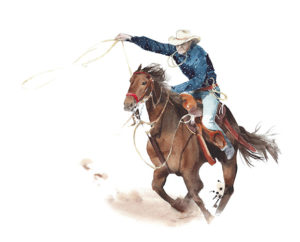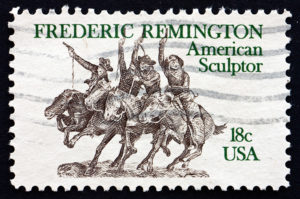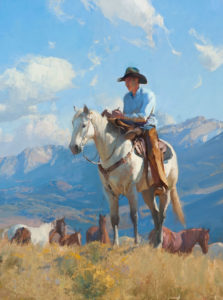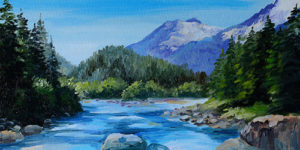Cowboy Paintings
 Some of the trending art right now are cowboy paintings, rodeo paintings, and generally, the art of the west. The adventurous spirit of the western genre has attracted one too many.
Some of the trending art right now are cowboy paintings, rodeo paintings, and generally, the art of the west. The adventurous spirit of the western genre has attracted one too many.
Notable western art painters have delved into the heart of the old west and created images of the time gone by. But, then, the wild west was a time of danger and romance for the men and women working in the harsh terrains of the open range. It was a time when “have the saddle, will travel” was the way of life.
Discover the new world of cowboy paintings, southwestern art, masters of the American frontier, and much more.
Famous Cowboy Paintings by Masters of Western Art
The subjects of the cowboy paintings were a working cowboy, sometimes cowgirls, horses, and cattle in a real-life situation and rodeo. They show the cowboy’s love of riding, roping, and wrangling.
Here are some of the famous cowboy paintings of the 19th and early 20th centuries.
- True Love – This undated masterpiece by AR Mitchell is one of the most popular and highly evocative illustrations of the 19th century west.
- Cowboy Singing – The 1892 painting of a western banjo player is by American artist Thomas Eakins. He is known for his style of realism and seated portraits in low light.
- Vaquero – This historic 1890 oil painting by Frederic Remington brings to view the ruggedness of the western landscape, the cowboy on a horse, the blazing sun, and the clear sky.
- Cullin’ the Herd – This undated oil painting is by Charlie Dye, a cowboy turned illustrator and painter. He helped found the Cowboy Artists of America. His works were mostly of cowboys and life in the rough terrains.
- Rounding Up the Herd – In the mid-20th century, self-taught artist Olaf Wieghorst emerged as the heir to the Remington and Russell style of historical art. The Danish-born artist’s love for painting western history, horses, the American cowboy, and Indians.
- Incident Near Square Butte – A cowboy’s day is filled with accidents and sudden death; such is the harsh reality of life. This 1897 oil painting by America’s most significant, working-cowboy artist, Charles Russell, clearly reveals the dangers for the viewers.
Original artwork of the masters is generally found in various museums, namely Gilcrease Museum, Tulsa, A.R. Mitchell Museum of Western Art, Trinidad, Texas Buffalo Bill Historical Center, and Desert Caballeros Western Museum, Wickenburg. In addition, however, high-quality recreations and prints of the originals are available for purchase in galleries across the country.
Which Great American Artist Painted the Old West?
Frederic Remington is famous for his paintings of the wild west. Additionally, he is also an illustrator and also sculptor. His works depict the cowboys, the harsh desert lands, and also US cavalry.
Another notable artist of mention is Charles Marion Russell. He has created close to 2000 paintings of Indians, cowboys, and the landscapes of the west. He depicted a picture of the mythic American West in his paintings.
Famous Artists of the American Frontier
Charles Marion Russell, Frederic Remington, and Thomas Moran are one of the few painters who captured the beauty of the wild west in their oil paintings. Their art explored the Western states, cowboys, ranchers, and Indian themes. They also chronicled the history of events (like the exploitation of the west) for future generations to see. The artists from this period didn’t mainly come from the western frontier.
Here are the well-known artists of the 19th century.
Charles Marion Russell (1864-1926)
Charles Marion Russell was one of the most prolific artists who painted western landscapes and also cowboy paintings. You can find his works in over 50 museums in the United States and around the world. He preferred muted color palettes with a sense of realism in his cowboy paintings.
His painting style included cowboys, landscapes, and Native Americans, generally inspired by his visits to nationals parks in Arizona, Colorado, and California. Charles’ favored painting mediums include oils, gouache (a type of watercolor), and sculpture. You can still find his bronze sculptures in different venues. However, there are only limited copies; these pieces are numbered like print and collectible items.
Albert Bierstadt (1830-1902)
Albert Bierstadt, a German-American painter, is known for his romantic paintings of beautiful places like Yosemite, Californian landscapes Yellowstone, etc. He uses a technique called “chiaroscuro” to create romance and grandeur in his paintings. The technique manipulates the contrast between light and darkness to create a realistic look.
Albert Bierstadt’s work helped Easterners appreciate the lands that later became part of the U.S. National Park System. His works now appear in over 100 museums across the United States. In addition, they fueled the imagination of many Americans who settled in the West. He worked on many mediums, including oils, gouache, watercolors, pastels, inks, and charcoal.
Thomas Moran (1837-1926)
Thomas Moran is an English-born painter who is known for the western landscapes. His signature style of painting is the usage of intense shades of color, which captures the grandeur and the beauty of Yosemite and Grand Canyon national parks.
Moran’s preferred mediums include oils, watercolor, gouache, printmaking, lithography, and engraving. His paintings are in more than 100 museums and galleries across the globe.
George Catlin (1796-1872)
George Caitlin is known for his ethnographic portraits of 48 distinct Native American tribal groups. After traveling with them for more than eight years, he learned more about the culture of Native Americans than most other white people of his era. During this period, he painted over 500 portraits showing Native Americans in their full regalia.
These portraits have their spot in the history books for their historical/ethnographic content, as well as for their vivid depictions of hundreds of subjects. Other than that, he was also a painter and printmaker who worked in oils and watercolor.
Frederic Remington (1861-1909)
 Frederic Remington is rightfully called the grandfather of Western art. He was fascinated by the “Wild West” and traveled in the West collecting subject material. However, he never lived nor experienced the western lifestyle. He was primarily a spectator preferring to be based in Newyork.
Frederic Remington is rightfully called the grandfather of Western art. He was fascinated by the “Wild West” and traveled in the West collecting subject material. However, he never lived nor experienced the western lifestyle. He was primarily a spectator preferring to be based in Newyork.
Being both a painter and a sculptor, his themes were often cowboys, Native Americans, and horses. His first sculpture (cast in bronze) and most famous work was “The Broncho Buster” (October 1895). Frederic Remington’s work is featured in over 80 museums across the U.S.
Things to Know Before Buying a Cowboy Painting
The web has been a haven for buyers and sellers alike from all parts of the world. You can sell or buy hard-to-find paintings that you wouldn’t otherwise have access to. Many people have successfully and happily purchased paintings and other art on the Internet. However, buying online, particularly artwork, comes with its own challenges.
Ensure that you thoroughly research the art and the artist before buying a cowboy painting. And also the legibility of the seller or website. Here are a few other points you may have to consider if you want a cowboy painting in your art collection:
- Are you looking for originals? If so, you may want to make sure the item is original and not a recreation. If it’s the latter, you can find phrases similar to “like an original,” and they appear in the search results along with originals.
- Look for the abbreviation OOAK in the description of the paintings for sale. It means “Original and One of a Kind.”
- What is the medium of the painting? While canvas is standard, do not take this for granted. Cowboy paintings on a good quality canvas last long.
- Is it framed or unframed? Does the frame add value to the painting? What is the condition of the frame?
- If in any doubt, ask questions before you buy. It is safer to be informed rather than disputing the purchase.
Conclusion
Delving deep into the history of South Western art, you’ll discover painters who recreated images of an era gone by, places, and events of adventure. Cowboys and Indians are the two essential themes of western paintings. These paintings demonstrate the daily life and the activities of the cowboys and the Native Americans.
Cowboy paintings are still growing in popularity and inspiring artists. Many painters still seek this genre for the same reasons as the painters of the 19th century, the rough mountainous terrains, near-death experiences, and difficult circumstances. From Teal Blake to Jim Carson, various artists still capture the images of cowboys riding, bucking stallions, raging rivers, and more.
 Fine Art Publishing has a vast collection of cowboy paintings from nationally-acclaimed and world-famous western art painters like Howard Terpning. Shop his vast collection of beautiful paintings in his complete catalog today!
Fine Art Publishing has a vast collection of cowboy paintings from nationally-acclaimed and world-famous western art painters like Howard Terpning. Shop his vast collection of beautiful paintings in his complete catalog today!
 People have been painting for more than 30,000 years now. Did you know that the earliest oil painting is from the 14th century? But landscapes not so much; they are relatively new. It took much longer for it to evolve into the popularity it has today.
People have been painting for more than 30,000 years now. Did you know that the earliest oil painting is from the 14th century? But landscapes not so much; they are relatively new. It took much longer for it to evolve into the popularity it has today. Landscapes did not always have the recognition it has now. With the Barbizon School’s birth, the nature of the paintings turned to be more open-air with nature, green forests, rocky cliffs, fields, etc.
Landscapes did not always have the recognition it has now. With the Barbizon School’s birth, the nature of the paintings turned to be more open-air with nature, green forests, rocky cliffs, fields, etc.